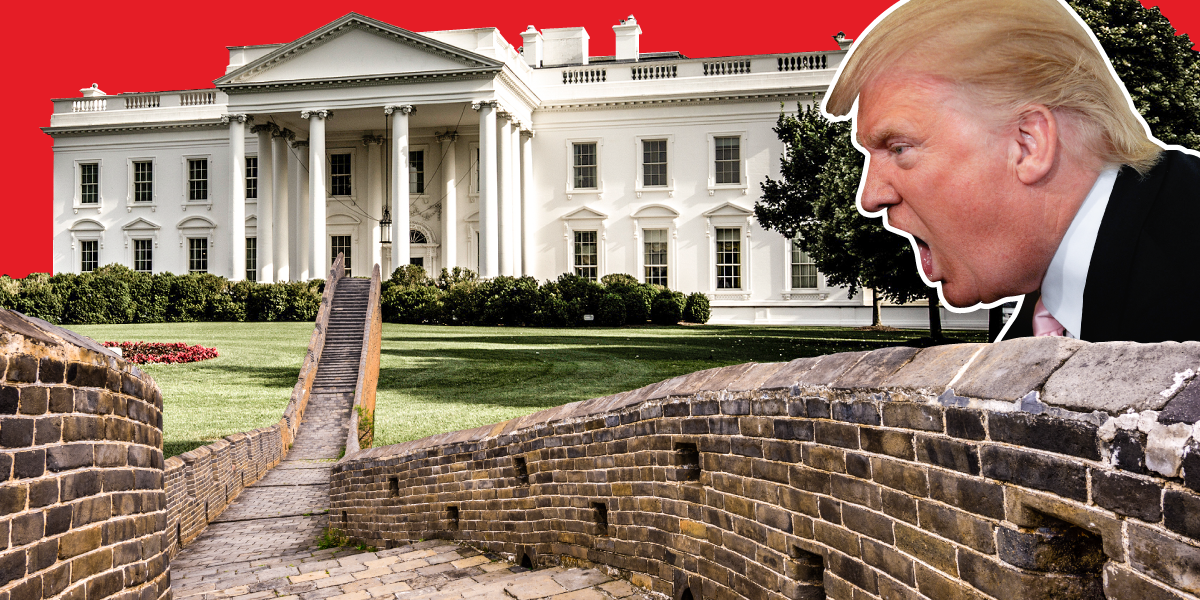- President Donald Trump on Friday threatened to hit China with tariffs on another $267 billion worth of goods.
- That would be in addition to existing tariffs on $50 billion worth of goods and apparently imminent tariffs on another $200 billion.
- The move would bring the US-China trade war to a fever pitch.
- US stock indexes dived following the news.
President Donald Trump elevated trade-war rhetoric with China to a fever pitch on Friday, threatening tariffs on another $267 billion worth of Chinese goods.
Speaking with reporters on Air Force One, Trump said long-threatened tariffs on $200 billion worth of Chinese goods would “take place very soon” – with more on the way.
“I hate to do this, but behind that there is another $267 billion ready to go on short notice if I want,” Trump said.
If Trump follows through with both threats, tariffs would be imposed on $517 billion in Chinese goods coming into the US – virtually everything coming from the country. Last year, the US imported $505 billion worth of goods from China.
A White House spokeswoman, Lindsay Walters, told reporters that the US Office of the Trade Representative did not have a time frame and would continue to "run their process" on the set of tariffs on $200 billion of goods.
China threatened to retaliate to that amount with tariffs on $60 billion worth of US goods, meaning almost all US goods sent to China would be subject to tariffs.
The back-and-forth is the culmination of months of threats and negotiations.
Trump first threatened tariffs on $50 billion worth of Chinese goods in March in response to US claims of Chinese intellectual-property theft. Since then the two sides have lobbed threats and tariffs in an attempt to get the other side to back down.
Economists argue Trump's tariffs will cause the cost of goods to increase for US businesses and consumers. That could slow business investment and reduce consumer spending, leading to an economic slowdown. Already, some small US businesses have said the tariffs have prompted them to lay off workers and scale back plans to grow their business.
Michael Zezas, Morgan Stanley's chief US piublic policy strategist, said the new threat was proof that the trade war threat was not in retreat.
"News that the US is considering tariffs on an additional $267bn of imports from China underscores our view that the trade conflict will remain in an escalatory cycle as the two sides are at a fundamental impasse," Zezas wrote.
US stock indexes dropped after Friday's news, with the Dow Jones industrial average falling roughly 140 points, or 0.55%, as of 12:45 p.m. ET.
Here's a timeline of the US-China trade war so far:
- March 1: President Donald Trump announces tariffs on all imports of steel and aluminum, including metals from China.
- March 22: Trump announces plans to impose 25% tariffs on $50 billion worth of Chinese goods. China announces tariffs in retaliation to the steel and aluminum duties and promises a response to the latest US announcement.
- April 3: The US trade representative announces a list of Chinese goods subject to the tariffs. There is a mandatory 60-day comment period for industries to ask for exemptions from the tariffs.
- April 4: China rolls out a list of more than 100 US goods worth roughly $50 billion that are subject to retaliatory tariffs.
- May 21: After a meeting, the two countries announce the outline of a trade deal to avoid the tariffs.
- May 29: The White House announces that the tariffs on $50 billion of Chinese goods will move forward, with the final list of goods released June 15. The move appears to wreck the nascent trade deal.
- June 15: Trump rolls out the final list of goods subject to new tariffs. Chinese imports worth $34 billion would be subject to 25% tariffs as of July 6, with another $16 billion worth of imports subject to the tariffs at a later date. China retaliates with an equivalent set of tariffs.
- June 18: Trump threatens 10% tariffs on another $200 billion worth of Chinese goods.
- July 6: The first tranche of tariffs on $34 billion worth of Chinese goods takes effect; China responds in kind.
- July 10: The US releases an initial list of an additional $200 billion worth of Chinese goods that could be subject to 10% tariffs.
- August 1: Washington more than doubles the value of its tariff threats against Beijing, announcing plans to increase the size of proposed duties on $200 billion worth of Chinese goods to 25% from 10%.
- August 3: China says it will impose tariffs of various rates on another $60 billion worth of US goods if Trump moves forward with his latest threat.
- August 7: The US announces that the second tranche of tariffs, which will hit $16 billion worth of Chinese goods, will take effect August 23.
- August 23: The US imposes tariffs on another $16 billion worth of Chinese goods, and Beijing responds with tariffs on $16 billion worth of US goods.

